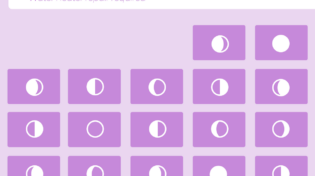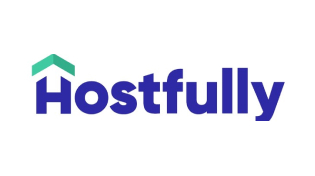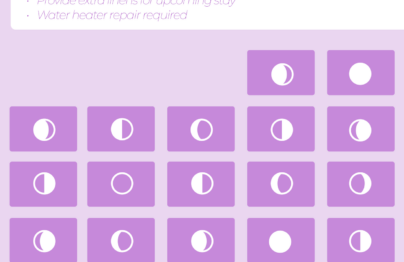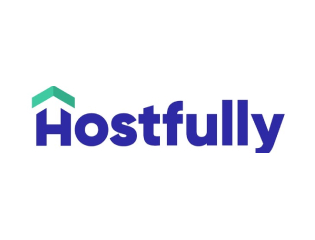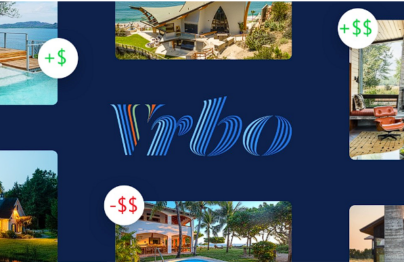Revenue Manager’s Tips for Pricing Configuration on Wheelhouse
September 28, 2021 | John DeRoulet
Revenue Management is a complicated activity even for experienced pros in the industry. There are tons of levers and valid strategies for pricing in the marketplace, each impacting the other. You will often hear from Revenue Managers and Data Analysts that pricing is often “more an art than a science.” The truth is, it’s both!
Using a platform like Wheelhouse for pricing and Revenue Management can greatly increase your efficiency, accuracy and ROI. However, before things are simplified we must put in some work on the front end to ensure things are rolling forward without a hitch. Often, the myriad of choices and options can be overwhelming.
In this article I hope to offer you some tips that will simplify your onboarding and configuration and provide some strategic questions to consider both initially and as you price going forward.
Preconfigure: Easier to Compare than to Invent
Inventing is hard. It is much easier to be an editor and that is no different in Revenue Management. Whether you know your markets like the back of your hand or are just learning the ropes, you have a framework of experience to draw from and that is a good place to start either in aligning your revenue system to your pricing assumptions – or using it to ask questions about your current strategy.
Below is a framework for pre-configuration that can help turn a white canvas into a painting awaiting its finishing touches.
Base Rate, Weekend, Seasonality
Set the Base Rate Settings (Base Rate, Weekend Adjustment, Seasonality): For most professional managers, I recommend starting with:
- Aggressive Base Rate
- Recommended Weekend/Seasonality Adjustments. Sometimes I will start with an Aggressive Weekend Adjustment for top performing portfolios
Note: This is not necessarily where you end up as we recommend review of the curves and repositioning based on your personal expertise for your portfolio however it is a good baseline to start the comparison.
Last Minute Discounts
Input a Last Minute Discount Schedule: Generally I start with something a little more aggressive than the Wheelhouse preset however Recommended and Aggressive are generally fine as well.
Example: Starts Earlier and Cuts Deeper
- Within 2: 0%
- Within 7: 20%
- Within 14: 15%
- Within 21: 10%
- Within 28: 5% *Optional based on Room Type
Notes:
- I usually kick the rate back up within 2 days of a stay date to mitigate the risk of “Last Minute: Lowest Rate” predatory reservations.
- Minimum Rate Settings will mitigate your cuts being too low. I often think of the lowest % as “bringing the rate to the floor” in order to increase occupancy, often by undercutting the market. Additionally, the floor is a control that you determine either according to your brand standard, pricing assumptions, or owner rules.
- For some larger room types (4+,5+, etc) bedrooms I consider starting the discount as early as 35 or 45 days at a low amount.
- Utilize the Market Report “Lead Time Distribution” chart to get an idea of your market’s lead time (particularly in higher seasons) and time discounts accordingly.
Far Future Premium
Input a Far Future Premium Schedule: For this I almost always recommend utilizing a custom schedule. There are 2 primary reasons for this.
- Post-Covid trends are volatile and booking windows have been shorter than historically which means you may want to protect revenue further out.
- Wheelhouse distributes 18 months of rates however the data after 1 year is limited. There’s less available inventory, rates are less optimized, and there is sparse booking signal
Recommendation: Be significantly more aggressive than the market rate in general. If you have properties consistently booking more than 1 year in advance, spend some additional time on those units.
Example:
- After 45: 5%
- After 75: 10%
- After 150: 15%
- After 240: 20%
- After 365: 50%
Notes: Similar to the Last Minute Discount, you will want to consider your Room Type and Booking Trends in the Market.
Recommendation: Primarily set this up to ensure you are priced correctly for the booking window in your high season to ensure rates are not too high. Generally speaking, set the price a bit higher outside of your booking window to maximize what you can capture when signals show the dates of greatest demand.
Some PM’s will also use this to “control” the booking window and limit early bookings by pricing high and maintaining availability. It is important to determine your strategy in regards to early/advance bookings and utilize the automation to assist.
Additionally, this configuration is not one that has to be considered static. I recommend establishing a habit of reviewing this 2-4 times per year (particularly as markets recover from Covid).
Minimum Rates
Input a Minimum Rate: Input something that seems reasonable (usually between $79 and $129) depending on Room Type and Market Rates. This is because very low demand dates can have a very low recommendation which may appear jarring and make comparison more difficult.
Eventually, you will want to put in the specific minimum rates relevant to your company, determined by owners, or take into account any inclusive fees if applicable. These can be done now or later.
Editor in Chief: Check your Listings
Inputting pre-configurations sets you up to then simply skim through your listings throughout the year and see rate curves that will need only minor tweaks. By checking all your listings you will build the confidence that you are on the right track while also giving each listing the proper time needed to be successful in the marketplace.
General Things to Look For
Trends related to configurations: Are your curves all just a little low? Are the far future rates not quite in line with your expectations or strategy? If you see this across multiple listings, rather than making changes on an individual listing basis, step back to the Pre-Configuration stage and make adjustments there. Especially if it relates to Base Rate, Weekend Adjustment, Last Minute Discount, or Far Future Premium features.
Mismatched Curves: If the Wheelhouse Curve doesn’t seem to match your existing pricing seasonality it may be worth digging into why to determine if you should adjust the WH curve or perhaps adjust your existing pricing assumptions. Using Market Report “Trends” can be very helpful in understanding high level trends, while the Wheelhouse “Insights” tab can give excellent details on why your specific listing is being priced the way it is. Remember…
Predictive = Prices around you
Reactive = Booking behavior
It may be worthwhile to go back to your performance records and double check your assumptions match what has happened in the properties. Finally, it is important to remember that the future may be volatile and may not match past trends.
Recurring Events: Take a look at your key recurring events. Wheelhouse will capture these and react to new or unknown events on a daily basis based on Bookings and Prices in the market. What you do however may be different from the market. Feel free to implement rate adjustments to be more in line with your experience on those dates by utilizing the “Portfolio: Calendar” view and implementing them with either the % rate adjustments or setting the fixed Rates.
Oddities or mistakes in your existing Rate Plan: It is worth checking to ensure something isn’t broken and gauging if you have an opportunity to capitalize on a mismatch.
Example: Missing Rates in Example Rate Plan:
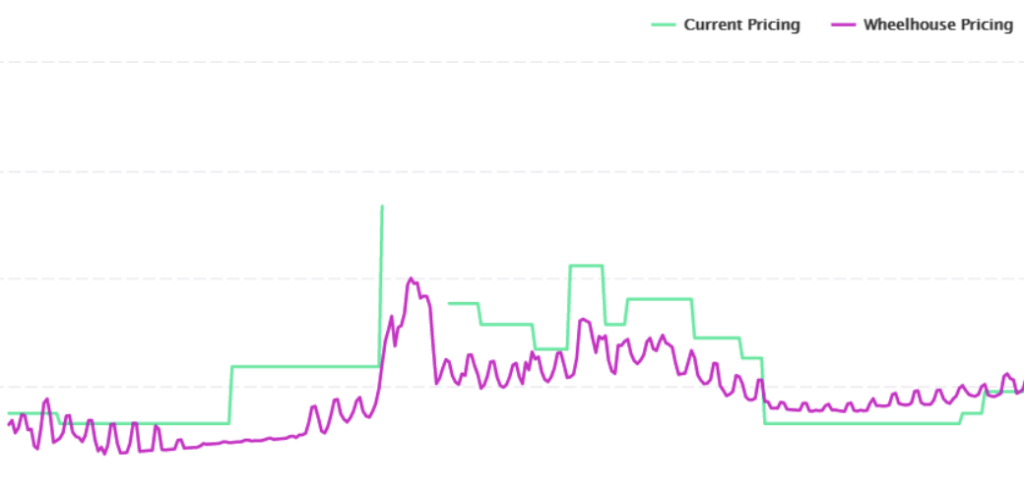
Eye Spy: Where to Look and What to Look For
By clicking into your listings there are a few easy places to see the Wheelhouse Rate Recommendation compared to your current rate position.
Settings: “Automate” will show you a visualization of the Wheelhouse Rate Recommendation overlaid with your current pricing.
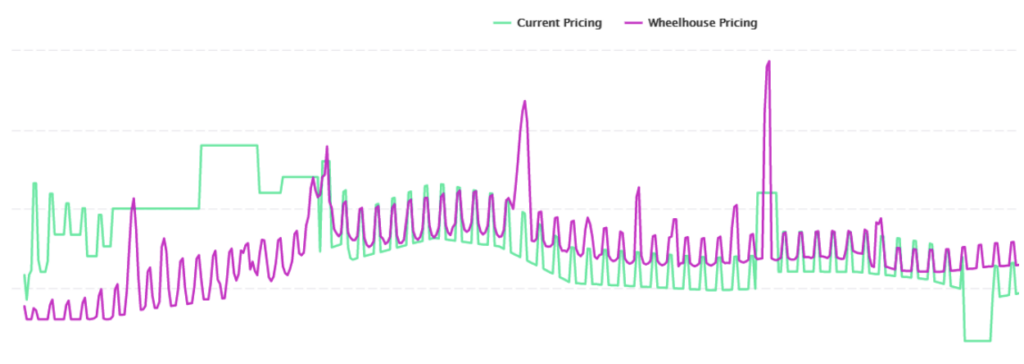
Insights: “Overview” also shows the Wheelhouse Recommendation and your current rate plan.
Toggle to “Customizations” to see how your configurations impact the rate and overlay both the Predictive and Reactive models.
Dig deeper into any model to see things such as Seasonality Curves, Customizations, and the weight between our two models.
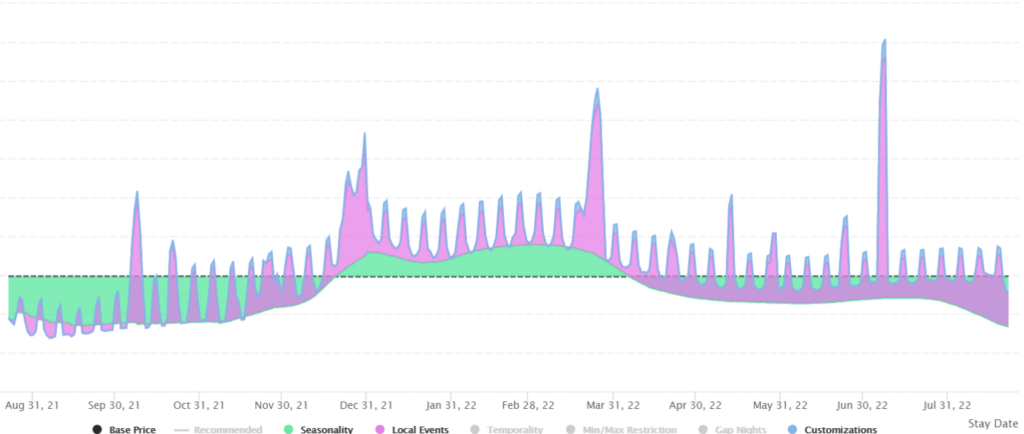
Now that we know where to look, we have to ask, “what is it that I am looking for,” in this sea of data?
The goal is to ensure your overall rate curve is “in the range” of your expectations and aligns with your pricing strategy. Keep in mind that the pricing will be different than your current price (and will update daily based upon demand!). That is ok! The question is, are the trends accurate enough for you to trust it?
Below are some tips of what to look for when scanning your units:
Is the general curve the same shape as your experience?:
- Are seasonality and day of week trends in line with your experience and expectations for the market? If not, is it possible there is an opportunity to optimize your pricing?
- Keep in mind that your Far Future Premium may also be affecting the “accuracy” of the curve. How these are adjusting the rates can be seen specifically on the “Insights” tab section under the Recommended Demand Model by selecting “Customizations” on the bottom of the graph.
Example:

Analysis:
- The curve here is mostly in line which brings quite a bit of trust. The range after March is a little high but this may be the result of the Preconfigured Far Future Premium and may not even be a negative based upon your strategy about early booking.
- Where the curve does not align is August – December 2021 which may be a source of concern or an opportunity. In this market however, a quick look at the Market Report “RevPar” trends will show that the seasonality actually drops in this period (both pre-covid and trending that way this year) which can give confidence in relying on the Wheelhouse recommendation over what was input previously.
Is the Curve Anchored in the right place?
Sometimes the curve is correct, however the overall recommended rate plan is a little lower or higher than your experience. Though Wheelhouse pulls in tons of individual qualities of the units, there are some which can only be understood qualitatively.
Not to mention, pricing tools in general cannot quantify certain aspects of your sales, distribution, return guests, and reviews which may impact your performance. If this is the case, it is best to set a Custom Base Rate to anchor that line where your experience makes you most comfortable.
Is a specific Season of the curve anchored in the right place?
Sometimes the curve overall is correct however you may know that your high season is able to capture more in the market than our model can see.
Month-specific adjustments to the base rate can be altered in the “Seasonality Adjustment” Tab. Because this configuration is a bit more complex in how the input affects the output, I would recommend using this feature only if it’s a trend across multiple units – and be somewhat conservative in your adjustments!
Additional adjustments or more specific adjustments are more easily made (and managed) by applying % changes or Fixed rates via the Portfolio: “Calendar” view.
Are there Specific Dates you really know and want reflected in your pricing?
- Experienced managers know how their properties sell historically, especially during peak seasons. The way your sales and distribution works may allow you to operate a bit outside the market, and therefore contrary to Wheelhouse recommendations.
- While Wheelhouse will assist you in understanding demand and capitalizing off of nonrecurring demand, you may also want to take more direct control over the dates you know best.
- You may implement these rate changes as Custom Rates by either a % increase (which allows the algorithm to continue to work underneath) or setting a Fixed Rate with what you know to be tried and true. The easiest way to implement this is via the Portfolio: “Calendar” view where you can see both your Rates and Occupancy and apply these adjustments in bulk with just 3 clicks!
This list is a pretty comprehensive list, however as you practice you will find that it can go pretty quickly (1-2 minutes per listing). Furthermore, you will be prepared to turn on your pricing with a foundation of confidence that you checked your listings, trust the recommendations, and know where to go & what levers to pull when you want to make changes!
Pre-Flight Checklist: What else you need before turning on!
After getting your pricing in line, there are a few other pieces that must be configured prior to turning on your pricing.
Minimum Length of Stay
MLOS must be set prior to turning on – otherwise you may be making 1-night reservations you don’t want. Wheelhouse offers a dynamic set of rules to establish your MLOS.
Recommendation: Use a mix of Global, Day of Week, and Time Based rules with Gap Nights turned on.
Complex Seasonal Rules
You may utilize the Date Specific rules which can be set for entire seasons and will overwrite any other configurations.
Recommendation: Determine if you can use a combination of Global and Time Based Minimum Stays to achieve something similar to your current seasonal rules, yet more dynamic to ensure your high demand season is protected.
This may mean your low season has a more restrictive MLOS until within a certain time, however if this aligns with your booking window it should have minimal effect on your bookings and may result in better, longer term stays further out. One may also consider reducing the Far Future Premium if this is the case as you will be requiring longer stays.
Example MLOS Settings: 2 Bedroom in Miami
- Global Minimum: 2 (nights)
- Friday/Saturday: 3
- Time Based MLOS:
- Within 30 Days: 2
- Within 10 Days: 1
- Within 3 Days: 2
- After 75 Days: 3
- Date Specific MLOS:
- March 1st - April 16th: 4 (for Spring Breaks)
- Gap Nights
- Turned on
- Allow Single Night Stays

Minimum Price: Configure to match your expectations and any rules the owners have set. No matter what we’re observing in the market, we will never go below your parameters.
Additional Considerations
Inclusive vs Exclusive Cleaning Fees:
Most managers utilize a cleaning fee to cover the costs of cleaning, however some companies include these fees in the nightly rate. It is very important to understand this when setting your minimum price to ensure that no reservation runs the risk of actually losing money!
Recommendation: Set the Minimum Price to align with the Minimum Length of Stay to ensure that rate is built in.
Both Minimum Length of Stay and Minimum Price offer dynamic, time-based rules so they can be aligned.
Check with your PMS to see how these fees are added in. It may be the case that these fees are added by the PMS after receiving the rate from Wheelhouse and thus would not need to be adjusted.
Rule of Thumb for Inclusive Fees: Minimum Rate = ( [Cleaning Cost] / [Lowest MLOS] ) * [1.Revenue Margin for Roomnight]
Long-Term Stay Discounts
For properties that have MLOS restrictions of 7+ or even 30+ nights, consider how the transient pricing translates to these properties. Many users successfully leverage our transient demand to boost mid- and long-term stay revenue.
It is important to understand that the transient rate where demand is visible is generally the highest and thus you may want to utilize the following Base Rates when considering your rate position:
Base Rate and/or Weekend Adjustment: Conservative
These may be mixed and matched such as Recommended Base and Conservative Weekend Adjustment. Again, utilize your own rate plan as a guideline to leverage your experience.
Though we will be pricing at the daily level, you can add up the rate value of a week or month to get an idea of how the Wheelhouse Recommendation compares to a daily rate.
This can be done by selecting dates on the Calendar tab or by going to the Portfolio: Calendar view, selecting “Recommended Rates” in the upper right, and exporting the rates for analysis in a google sheet or excel.
Discounting vs Base Rate
You may also utilize long-term stay discounts to drop the rate. In this situation, you might opt against adjusting the Base Rate, or use a combination of discounting and a more conservative rate position.
Check with your PMS to see the options for length-of-stay discounting available, how they distribute to different channels (if at all), and if the Wheelhouse functionality is supported. In the event that primary OTAs do not receive discounting in the way you intend, you may instead opt to utilize a more conservative Base Rate.
We hope you’ve found this article resourceful and always welcome feedback! Want something else included? Just let us know – hello@usewheelhouse.com
Blog search
Recent posts
-
Wheelhouse Presents: Ratestrology
April 1, 2023 | BY Andrew Kitchell
-
Short-Term Rental Agreement: What to Include & Free Templates
January 17, 2023 | BY Hailey Friedman
-
Hostfully Review: Vacation Rental Management Software [2023]
January 14, 2023 | BY Hailey Friedman
-
Escapia Software Review [2023]
January 6, 2023 | BY Hailey Friedman



